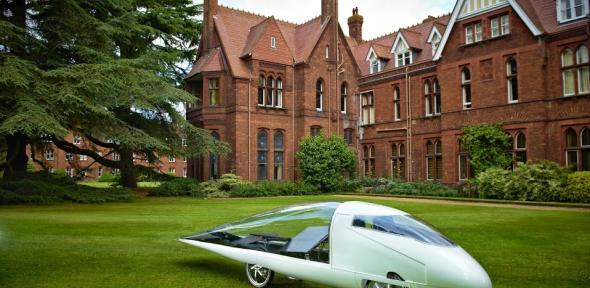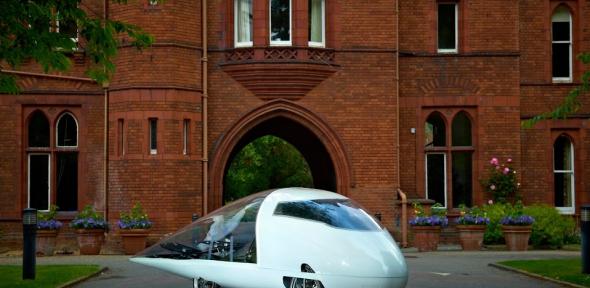
A group of Cambridge students are hoping that their game-changing design of solar car will make them the first British winners of the World Solar Challenge.
A group of Cambridge students are hoping that their game-changing design of solar car will make them the first British winners of the World Solar Challenge.
The cumulative effect is a radical, race-winning design that also incorporates elements that could be used more widely in a low-carbon future
Keno Mario-Ghae
A new solar car which, according to its creators, “rewrites the rulebook” for green vehicles, has been designed by students aiming to become the first British team to win the World Solar Challenge.
The prototype, which has been named “Resolution”, was built by engineers at the University of Cambridge. It is being unveiled in a road-test today (July 5th) at the Millbrook Race Track, near Bedford.
The team will be taking the car to Australia in October, where they will compete against rivals from all over the world in a 3,000km race from Darwin to Adelaide, in which the vehicles must be powered by the sun alone.
Their hope is that Resolution’s radically different design, in particular a set of moving solar panels which maximise power by tracking the path of the sun across the sky, will enable them to take first place where others have failed. No British team has ever won the competition in its 26-year history.
Keno Mario-Ghae, team manager for Cambridge University Eco-Racing, based at the University’s Department of Engineering, said: “Resolution is different because she overcomes one of the main limitations that affect most solar cars.”
“Traditionally, the entire structure of a solar car has been based on a trade-off between aerodynamic performance and solar performance. That’s how they’ve been designed for the past 10 years, and that’s why they all tend to look the same.”
“We turned the concept on its head. Our reasoning is that solar performance needs to adapt to the movement of the sun, but the car needs a fixed shape to be at its most aerodynamic. To make the car as fast and powerful as possible, we needed to find a way to separate the two ideas out, rather than find a compromise between them.”
The solution the team eventually hit upon involved embedding the solar panels within an aft-facing tracking plate. This plate follows the sun’s trajectory, and moves the panels themselves, so that they are optimally positioned at all times. The team estimate that this will give the car 20 per cent more power than it would have otherwise had.
This structure is placed under a canopy which forms part of the teardrop shape of the vehicle as a whole. The design is a departure from the “tabletop” look of most other solar cars, but is more aerodynamic. Because it encases the solar panels, rather than making them part of the shape, the question of power generation does not compromise the car’s aerodynamics.
Resolution measures less than 5m in length, is 0.8m wide and about 1.1m in height. Driving her across the Australian desert is likely to be a claustrophobic experience - in fact, the driver must be a maximum of 5’ 3’’ tall! These, however, are deliberate concessions made by the team for the sake of making the vehicle as fast and efficient as possible in the hope of winning the race. In the future, more conventional solar vehicles may well adopt similar ideas, but opt for comfort, rather than speed.
The car weights 120kg, and can reach a top speed of almost 140 kilometres per hour (almost 87 miles per hour), but needs about the same amount of power as a hairdryer. It achieves this by maximising efficiency at every level - for example, the motor is located in the hub of the wheel, eliminating the need for gears, chains or differentials which would lower its efficiency overall.
For those small enough to squeeze inside the cockpit, the vehicle has also been fitted with on-board telemetry, an “intelligent cruise control” which takes into account traffic, weather and driving style, and will advise the team on how to optimise the vehicle’s efficiency during the race itself.
2013 will be the third time that student engineers at Cambridge have taken part in the race. The first attempt, in 2009, was beset by battery issues and saw the team finish 14th out of 26 entrants. After a substantial redesign, the University’s Eco-Racing team entered again in 2011. That race was hampered by bush fires and poor weather conditions, and only seven of the participating cars were able to finish using solar power alone.
The team raises its own funds to develop and build the car, using a combination of corporate sponsorship and individual donations through a “Friends of CUER” scheme. The students involved also have to manage the manufacturing schedule carefully, as part way through the course of building the vehicle everything is necessarily put on hold while they do their exams! The final product is the result of a huge, collaborative effort involving 60 students.
“Efficiency is where our real strength lies and this is how we will be hoping to compete with the bigger teams entering the Challenge this time around,” Mario-Ghae added. “A huge amount of careful planning has gone into this project. It has involved research not just in terms of engineering and aerodynamics, but into the materials we use, the modelling behind the design, and the optimisation of the solar cells that power the car.”
“The cumulative effect is, we think, a radical, race-winning design that also incorporates elements that could be used more widely in a low-carbon future. No British team has won this race before, but there is no reason why we can’t be the first to do it.”
For more information about this story, please contact Tom Kirk, Tel: 01223 332300, thomas.kirk@admin.cam.ac.uk
This work is licensed under a Creative Commons Licence. If you use this content on your site please link back to this page.









